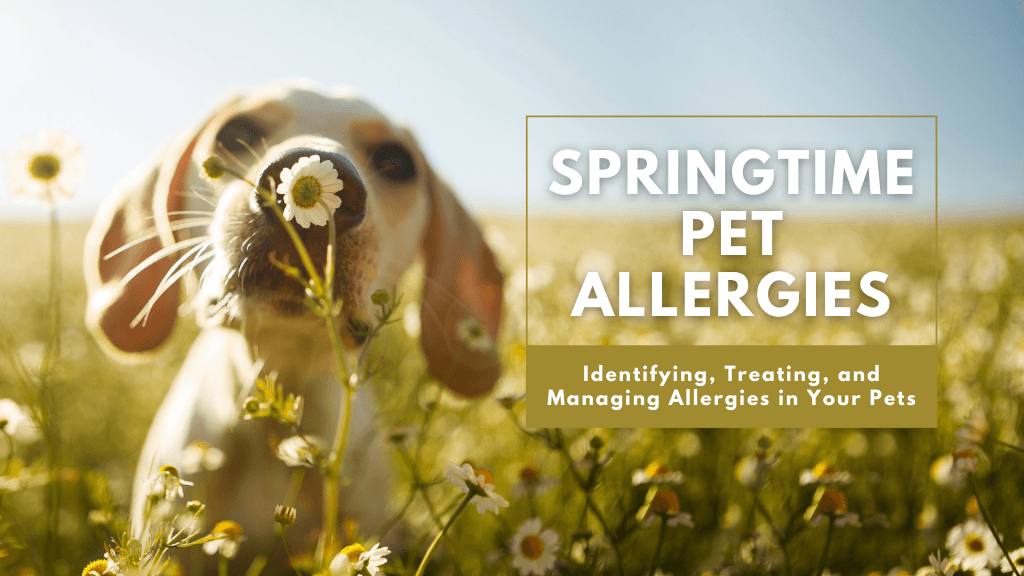Springtime Pet Allergies: A Guide to Identifying, Treating, and Managing Allergies in Your Pets
)
As the warmer months of spring bring new growth and fresh air, they also stir up allergens that can affect our beloved pets. Just like humans, dogs and cats can suffer from seasonal allergies caused by pollen, grass seeds, dust, and spores. These irritants can make your furry companions uncomfortable and lead to excessive scratching, skin irritations, and other health issues.
In this guide, we’ll walk you through the key signs of springtime allergies in pets, along with treatment and management tips to ensure your pet enjoys the season as much as you do.
Understanding the Signs of Allergies in Pets
Just like us, our pets can suffer from allergies—though the symptoms may manifest differently. Instead of watery eyes or sneezing, cats and dogs often show signs of allergies through their skin. Here are the key symptoms to watch out for:
Excessive Scratching and Licking Itchy skin is one of the most common signs of allergies in pets. If your dog or cat is constantly scratching, licking, or biting their skin, it may be a sign they’re reacting to allergens. Pets may even rub against furniture to relieve the itch, which can lead to further irritation.
Hair Loss Chronic scratching and biting due to allergies can lead to noticeable hair loss. This is especially common in pets allergic to grass seeds, where over-grooming causes patches of thinning hair. Keep an eye out for any bald spots or signs of excessive grooming in your pet.
Red Sores and Skin Irritation Allergies can cause your pet to scratch or bite themselves to the point of breaking the skin. This can lead to painful red sores, which can ooze or become infected if left untreated. Immediate intervention is necessary to prevent further complications.
Ear Infections Allergens can enter your pet’s ears, causing intense itching and irritation. If your pet is scratching their ears frequently or shaking their head, it could indicate an ear infection brought on by allergens. Prompt treatment is essential to prevent the infection from worsening.
Respiratory Problems Although less common, some pets may experience respiratory issues as a result of allergies. Symptoms like sneezing, coughing, or a runny nose can indicate that your pet is having trouble with airborne allergens.
Taking Steps to Help Your Allergic Pet
Managing your pet’s allergies may feel overwhelming, but there are several effective strategies to help alleviate their discomfort and keep them healthy during springtime:
Regular Bathing and Grooming Bathing your pet regularly with a hypoallergenic shampoo can help remove pollen, dust, and other allergens from their coat. Grooming, especially brushing, will also reduce the accumulation of irritants. This is particularly important for pets with long coats.
Paw Care Allergens can build up on your pet’s paws, causing irritation. Make sure to rinse or wipe your pet’s paws after walks or outdoor play. Trimming the fur around their paws can also help prevent the buildup of allergens.
Flea Prevention Flea allergies are a common issue for many pets. Ensure your pet is protected with a prescription flea preventative, as just one flea bite can trigger a serious allergic reaction. Flea control is crucial in managing overall skin health.
Reduce Environmental Allergens Keep allergens at bay by regularly cleaning your home. Vacuuming carpets, mopping floors, and washing your pet’s bedding can make a significant difference. Keep windows closed during peak pollen times to minimise exposure.
Consult Us Before giving your pet any antihistamines or supplements, consult our veterinary team. We can recommend safe and effective treatments tailored to your pet’s specific needs. Always seek professional advice to avoid potential side effects or complications.
Allergy Testing and Immunotherapy If your pet’s allergies persist despite your best efforts, allergy testing may be necessary to pinpoint the exact triggers. Immunotherapy, which involves exposing your pet to small doses of allergens over time, can help desensitise their immune system and reduce reactions.
Prescription Medications For severe cases, your vet may prescribe medications like corticosteroids or antihistamines to relieve symptoms. These treatments should always be used under veterinary supervision to ensure proper dosage and minimise side effects.
Dietary Modifications While less common, food allergies can exacerbate your pet’s symptoms. If your vet suspects a food allergy, they may recommend an elimination diet or hypoallergenic food to help manage your pet’s overall allergic response.
Seeking Veterinary Assistance
Springtime can be a challenging season for pets with allergies, but with the right care and treatment, you can help them feel comfortable and enjoy the warmer weather. By keeping a close eye on symptoms, maintaining good grooming habits, and consulting with our expert team you’ll be well-equipped to manage your pet’s seasonal allergies.
If you have any concerns or would like further advice, don’t hesitate to reach out to us. Together, we can ensure your furry friend stays happy and healthy during allergy season.
| Tags:Client InformationHealth AdviceProactive Pet Care |
)